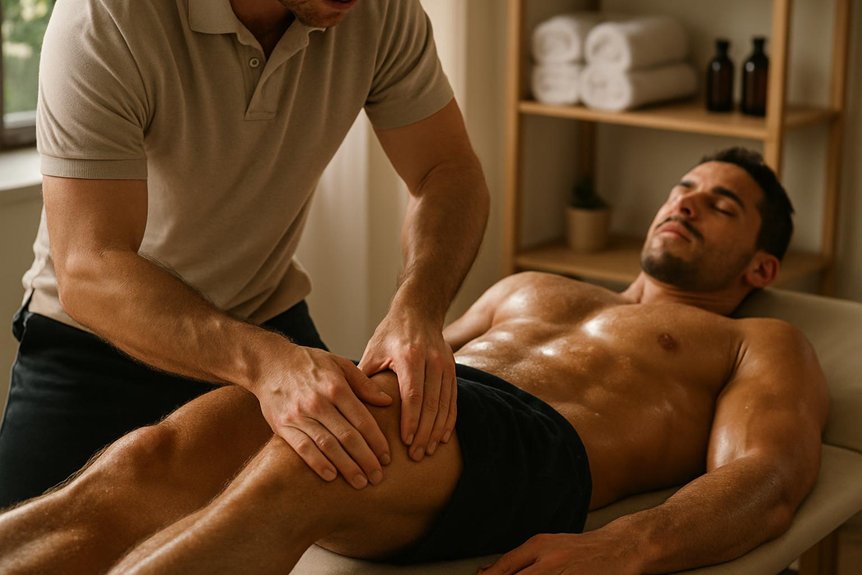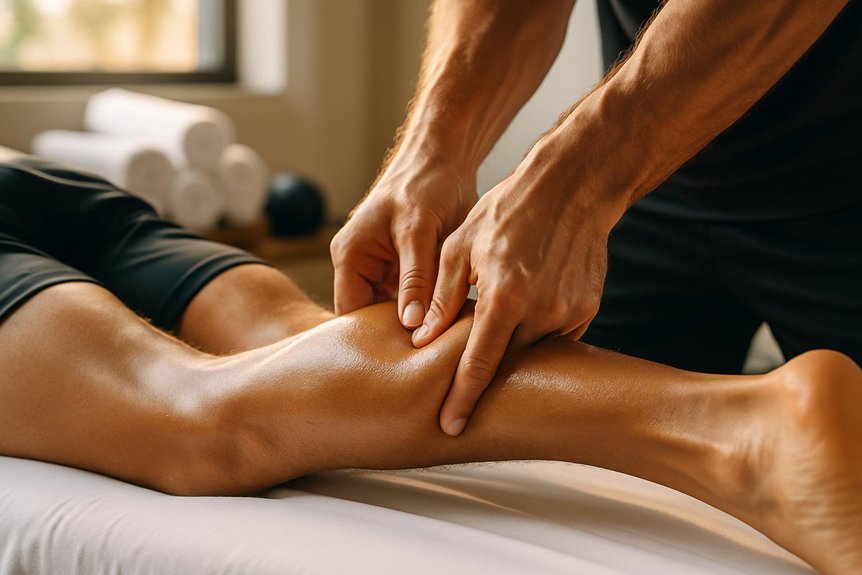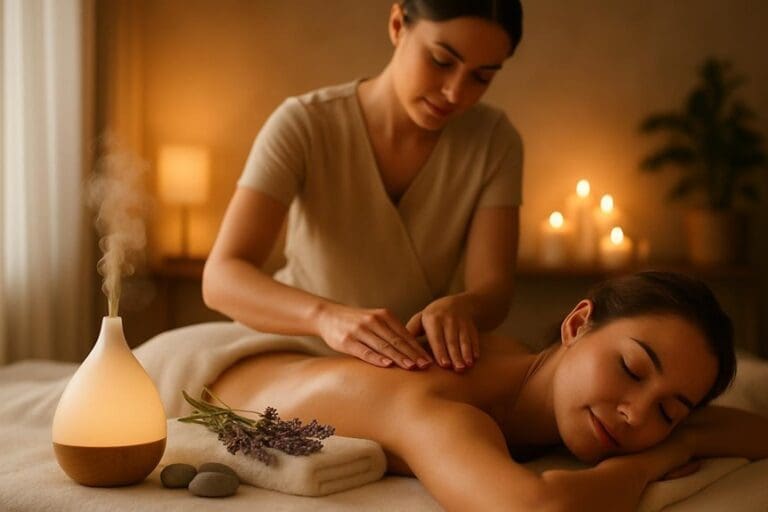To perform performance massage, the practitioner systematically assesses musculoskeletal concerns and goals, then applies techniques such as effleurage, petrissage, friction, and myofascial release to maximize circulation, reduce tension, and facilitate tissue recovery. The session occurs in a quiet, clean environment using hypoallergenic oils and proper draping. Communication ensures ideal pressure and comfort. Interventions are tailored to individual needs, with aftercare focusing on hydration and gentle stretching. Additional details outline targeted strategies for specific athletic issues.
Understanding the Purpose of Sports Massage

Why is it considered essential to athletic health and performance? Performance massage, as practiced by Spa & Massage, addresses both physiological and psychological demands imposed by training and competition. Evidence indicates that targeted manual therapy techniques—such as effleurage, petrissage, and friction—are effective in enhancing circulation, facilitating lymphatic drainage, and reducing neuromuscular tension. These interventions support expedited recovery, decrease delayed onset muscle soreness, and help prevent overuse injuries.
It is also instrumental in improving proprioceptive awareness and joint mobility, allowing athletes to achieve ideal biomechanical function. By modulating sympathetic nervous system arousal, treatment can promote relaxation and mental clarity. At Spa & Massage, therapists tailor each session to the unique requirements of the individual, ensuring that therapeutic outcomes are both restorative and performance-enhancing. In addition, one of the primary benefits of performance massage for athletes is its ability to support overall athletic performance by addressing both recovery and injury prevention.
Preparing the Environment and Gathering Supplies
A well-structured environment is fundamental to the efficacy of performance massage. At Spa & Massage, clinical protocols dictate that the treatment space be quiet, clean, and temperature-controlled to foster both physiological relaxation and psychological trust.
Soft lighting and neutral scents support a sense of calm intimacy, allowing for maximum neuromuscular engagement. The massage table should be hygienic and adjustable, with fresh linens arranged for comfort and privacy.
Essential supplies include hypoallergenic massage oils or creams—chosen to reduce friction without irritating the skin—and disposable face cradles for hygienic support. Therapists ensure that all equipment is sanitized between sessions, maintaining the highest standards of infection control.
Accessibility to towels, bolsters, and hydration further enhances the client’s comfort and supports the clinical aims of performance massage.
Assessing the Client’s Needs and Setting Goals
A detailed performance massage begins with a thorough assessment of the client’s injury history and current musculoskeletal concerns.
Clinicians at Spa & Massage systematically identify individual performance objectives to inform clinical decision-making.
This targeted evaluation enables the formulation of a personalized treatment strategy that aligns with the client’s unique therapeutic and athletic goals.
Understanding Injury History
Before initiating any performance massage intervention, thorough assessment of the client’s injury history is essential to inform clinical decision-making and establish appropriate treatment goals.
Detailed exploration of previous musculoskeletal injuries, surgeries, and chronic conditions enables therapists to identify potential contraindications and areas requiring modified techniques.
At Spa & Massage, practitioners take time to listen attentively, ensuring clients feel comfortable sharing sensitive information about past traumas or recurring discomfort.
By reviewing medical documentation where available, therapists gain insight into the injury’s mechanism, recovery progress, and any ongoing limitations.
This clinical information guides the selection of massage modalities and intensity, maximising safety while enhancing therapeutic outcomes.
Establishing this trust fosters a collaborative environment where clients are supported throughout their recovery and wellness journey, reflecting Spa & Massage’s holistic, client-centred philosophy.
Identifying Performance Objectives
How do therapists guarantee each session is tailored to the client’s unique athletic requirements? The process begins with a systematic assessment of the client’s current physical condition, training regimen, and specific performance objectives.
Therapists at Spa & Massage employ evidence-based intake protocols to elicit information about event schedules, target improvements—such as increased flexibility or accelerated recovery—and any functional limitations. This data guides the formation of precise, measurable goals in collaboration with the client, ensuring the therapeutic intervention remains client-centric.
Tailoring Treatment Approach
Effectively customising a performance massage session hinges on a systematic evaluation of the client’s musculoskeletal status, recent activity levels, and recovery demands.
At Spa & Massage, therapists conduct thorough assessments encompassing postural analysis, palpation of soft tissues, and detailed discussion of any pain, stiffness, or injury history.
This data informs the identification of specific focal areas and the integration of suitable manual techniques, such as myofascial release or deep friction, as clinically indicated.
Goal setting is collaborative and client-centred, taking into account both immediate concerns—such as alleviating muscular tension or promoting circulation—and longer-term performance objectives.
Therapists maintain open communication throughout, adapting their approach responsively.
This evidence-driven, tailored methodology ensures each performance massage session is *maximally* aligned with the client’s evolving physical and emotional needs.
Key Techniques Used in Performance Massage
While performance massage encompasses a range of therapeutic interventions, its efficacy derives from the strategic application of specific manual techniques targeting soft tissue structures.
Common techniques include effleurage, a gentle gliding motion used to warm tissues and promote circulation, and petrissage, which involves kneading and compression to release muscular tension.
Friction techniques are applied to break down adhesions and facilitate ideal tissue alignment, whereas tapotement—rapid, rhythmic percussion—can stimulate neuromuscular response.
Cross-fiber techniques further address localized restrictions.
At Spa & Massage, therapists integrate these evidence-based methods with precise pressure and attentive feedback, ensuring tailored care for each client.
This clinical approach allows for both the alleviation of muscular discomfort and the enhancement of athletic performance, while fostering a sense of trust and physical attunement.
Step-by-Step Guide to a Typical Performance Massage Session
Building upon the foundational techniques outlined previously, a typical performance massage session at Spa & Massage is structured to maximise therapeutic outcomes through a systematic, client-centred approach.
Each session commences with an in-depth consultation to assess musculoskeletal concerns, athletic demands, and treatment goals.
The therapist then employs targeted effleurage to warm tissues, followed by petrissage and friction techniques to manipulate deeper structures and promote myofascial release.
Throughout the session, communication is prioritised to maintain ideal pressure and client comfort.
Mobilisations may be integrated to support joint range of motion.
The use of hypoallergenic oils ensures smooth gliding and skin integrity.
Sessions conclude with gentle stretching and aftercare guidance, fostering a sense of trust and personal connection while supporting recovery and ongoing performance enhancement.
Addressing Common Problem Areas for Athletes
Athletes frequently present with musculoskeletal complaints such as tight hamstrings, shoulder tension, and calf strain. Each of these issues can impede performance and recovery.
Clinical evidence supports the use of targeted performance massage techniques to address these specific regions. These techniques promote improved tissue flexibility and reduced discomfort.
Spa & Massage therapists employ systematic assessment and tailored interventions to optimise mobility and functional outcomes in these common problem areas.
Easing Tight Hamstrings
Given the prevalence of hamstring tightness among physically active individuals, targeted performance massage techniques play a crucial role in alleviating discomfort and restoring ideal muscle function.
At Spa & Massage, therapists integrate myofascial release and deep longitudinal gliding strokes to address fascial adhesions and improve tissue pliability. Focused friction movements along the hamstring’s origin and insertion facilitate increased local circulation and promote neuromuscular relaxation.
Therapists apply maximum pressure, adjusting to the client’s tolerance, ensuring effective yet comfortable manipulation. Passive stretching is often incorporated to enhance muscle extensibility following massage.
Clients are encouraged to communicate sensations of tenderness or relief, fostering a collaborative and attentive environment.
These evidence-based protocols, as practiced in our clinics, are designed to support both recovery and ongoing athletic performance.
Releasing Shoulder Tension
Frequently, repetitive upper body movements and sustained postural demands predispose athletes to heightened tension within the shoulder girdle.
In our clinics, therapists employ targeted myofascial release, deep tissue techniques, and neuromuscular therapy to address hypertonicity in the deltoids, trapezius, and rotator cuff musculature.
Focused friction and trigger point decompression are applied with controlled pressure, ensuring ideal tissue response without exacerbating underlying irritation.
Evidence indicates that incorporating passive joint mobilizations alongside soft tissue manipulation enhances scapulothoracic mobility and reduces discomfort.
Spa & Massage therapists carefully select hypoallergenic oils to facilitate glide and minimize irritation, fostering a supportive environment that respects individual sensitivities.
Post-session, clients are advised on gentle active range-of-motion exercises to sustain improvements, reflecting our holistic commitment to athletic performance and sustained well-being.
Managing Calf Strain
How does persistent lower leg discomfort impede athletic function and recovery? Calf strain diminishes propulsion, impairs gait mechanics, and increases compensatory injury risk.
At Spa & Massage, therapists systematically assess tissue integrity and muscle tone. Evidence-based techniques, such as effleurage, deep transverse friction, and myofascial release, are employed to reduce adhesions and facilitate venous return.
Targeted stretching and gradual compression enhance local circulation, accelerating metabolic waste clearance and reducing inflammation. Clients are educated on self-management, including gentle calf stretches and hydrotherapy, to maintain elasticity beyond the session.
The approach at Spa & Massage prioritizes controlled, pain-free mobilization, tailored to the individual’s stage of recovery. This clinical, nuanced intervention supports ideal healing while fostering a sense of trust and reassurance in the therapeutic process.
Essential Aftercare and Recovery Recommendations
Ideal post-massage recovery is crucial for maximizing the therapeutic benefits of performance massage.
At Spa & Massage, therapists emphasize hydration post-session to facilitate metabolic waste removal and optimize tissue recovery. Clients are advised to engage in gentle stretching within their comfort range, supporting the restoration of muscle length and flexibility.
Application of cold or heat therapy may be recommended, contingent on individual response and clinical assessment. Rest is encouraged to allow neuromuscular systems to adapt and integrate therapeutic changes.
Monitoring for adverse effects—such as prolonged soreness or swelling—is essential; these should be communicated to a qualified professional promptly.
Regular follow-up sessions, tailored to activity levels and specific goals, enhance cumulative benefits.
This evidence-based approach underscores Spa & Massage’s commitment to extensive, client-centered aftercare.
Conclusion
In summary, mastering performance massage is akin to cultivating a well-tended garden—requiring precise technique, attentive observation, and adherence to best practices. Through evidence-based interventions and methodical application, practitioners can facilitate ideal tissue function, forestall maladaptive patterns, and support physiological restoration. By integrating these clinical principles, therapists illuminate the pathway to enhanced musculoskeletal resilience, ensuring both novice and seasoned athletes experience a harmonious confluence of performance, recovery, and sustained well-being.



